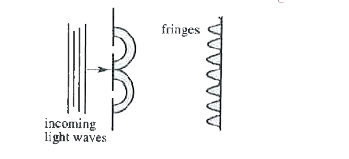In Young's double-slit experiment, if yellow light is replaced by blue light, the interference fringes become
Darker
Brighter
Wider
Narrower
The correct Answer is:D
To solve the problem regarding the effect of replacing yellow light with blue light in Young's double-slit experiment, we can follow these steps:
1. Understand the Concept of Fringe Width:
In Young's double-slit experiment, the fringe width (β) is given by the formula:
β=λDd
where:
- β = fringe width
- λ = wavelength of light used
- D = distance from the slits to the screen
- d = distance between the slits
2. Identify the Wavelengths:
- The wavelength of yellow light is greater than that of blue light. For example, yellow light has a wavelength around 580 nm, while blue light has a wavelength around 450 nm.
3. Analyze the Effect of Wavelength on Fringe Width:
- Since fringe width (β) is directly proportional to the wavelength (λ), if the wavelength decreases (as it does when switching from yellow to blue light), the fringe width will also decrease.
4. Conclusion:
- Therefore, when yellow light is replaced by blue light, the fringe width becomes narrower.
5. Final Answer:
- The interference fringes become narrower.
In Young's double-slit experiment, the fringe width (β) is given by the formula:
β=λDd
where:
- β = fringe width
- λ = wavelength of light used
- D = distance from the slits to the screen
- d = distance between the slits
- The wavelength of yellow light is greater than that of blue light. For example, yellow light has a wavelength around 580 nm, while blue light has a wavelength around 450 nm.
- Since fringe width (β) is directly proportional to the wavelength (λ), if the wavelength decreases (as it does when switching from yellow to blue light), the fringe width will also decrease.
- Therefore, when yellow light is replaced by blue light, the fringe width becomes narrower.
- The interference fringes become narrower.
Similar Questions
Knowledge Check
- Question 1 - Select One
A Young's double slit experiment uses a monochromatic source. The shape of the interference fringes formed on a screen is
AparabolaBstraight lineCcircleDhyperbola
In Young's double slit experiment, if one of the slit is closed fully, then in the interference pattern
View SolutionIn Young's doble-slit experiment, if the monochromatic source of light is replaced by white light, then one sees
View SolutionIn a Young's double slit experiment green light is incident on the two slits. The interference pattern is observed on a screen. Which of the following changes would cause the observed fringes to be more closely spaced ?
 View Solution
View Solution_E01_055_Q01.png)
In a young's double slit experiment, green light is incident on the two slits. The interference pattern is observed on a screen. Which of the following changes would cause the observed fringes to be more closely spaced?View SolutionA Young's double slit experiment is performed with white light.
View SolutionState two conditions to obtain sustained interference of light. In young's double slit experiment, using light of wavelength 400 nm, interference fringes of width X are obtained. The wavelength of light is increased to 600 nm and the separation between the slits is halved. if one wants the observed fringe width on the screen to be the same in the two cases, find the ratio of the distance between the screen and the plane of the slits in the two arrangements.
View SolutionIn Young's double sit experiment two light sources when placed at a distance d apart, then Interference pattem having fringe width w. If the distance between the sources is reduced to d/3, then fringe width would be
View Solution
